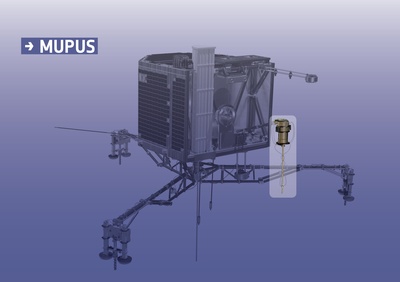Philae settles in dust-covered ice
MUPUS began observing the environment around Comet 67P/Churyumov-Gerasimenko once Philae was released from the Rosetta orbiter at 08:35 GMT on 12 November (this is spacecraft time; the signal confirming separation arrived at Earth just over 28 minutes later, at 09:03 GMT).
The first touchdown recorded by Philae occurred at 15:34 GMT (with the signal arriving on Earth at 16:03 GMT), but it later transpired that the harpoons and ice screws did not deploy as planned and the lander subsequently rebounded, experiencing two further touchdowns, at 17:25 and 17:32 GMT (spacecraft time), respectively.
Because part of the MUPUS package was contained in the harpoons, some temperature and accelerometer data could not be gathered. However, the MUPUS thermal mapper, located on the body of the lander, worked throughout the descent and during all three touchdowns.
At Philae’s final landing spot, the MUPUS probe recorded a temperature of –153°C close to the floor of the lander’s balcony before it was deployed. Then, after deployment, the sensors near the tip cooled by about 10°C over a period of roughly half an hour.
“We think this is either due to radiative transfer of heat to the cold nearby wall seen in the CIVA images or because the probe had been pushed into a cold dust pile,” says Jörg Knollenberg, instrument scientist for MUPUS at DLR.
The probe then started to hammer itself into the subsurface, but was unable to make more than a few millimetres of progress even at the highest power level of the hammer motor.
“If we compare the data with laboratory measurements, we think that the probe encountered a hard surface with strength comparable to that of solid ice,” says Tilman Spohn, principal investigator for MUPUS.
Looking at the results of the thermal mapper and the probe together, the team have made the preliminary assessment that the upper layers of the comet’s surface consist of dust of 10–20 cm thickness, overlaying mechanically strong ice or ice and dust mixtures.
At greater depths, the ice likely becomes more porous, as the overall low density of the nucleus – determined by instruments on the Rosetta orbiter – suggests.
Looking to the future, Tilman Spohn says, “MUPUS could be used again if we get enough power. Then we could perform direct observations of the layer that the probe is standing in and see how it evolves as we get closer to the Sun.”
While the full analyses of the lander’s multiple touchdowns and the data collected during descent and landing are on-going, the Rosetta orbiter continues its science mission at Comet 67P/C-G. Over the next year it will follow the comet as it draws ever nearer to the Sun, watching how its surface and surrounding environment evolves.
About MUPUS
The thermal probe of MUPUS was originally developed at the Institute of Planetology of the University of Münster together with the Space Research Centre in Warsaw and other international partners. It is maintained and operated by an international team led by the DLR Institute of Planetary Research in Berlin.
